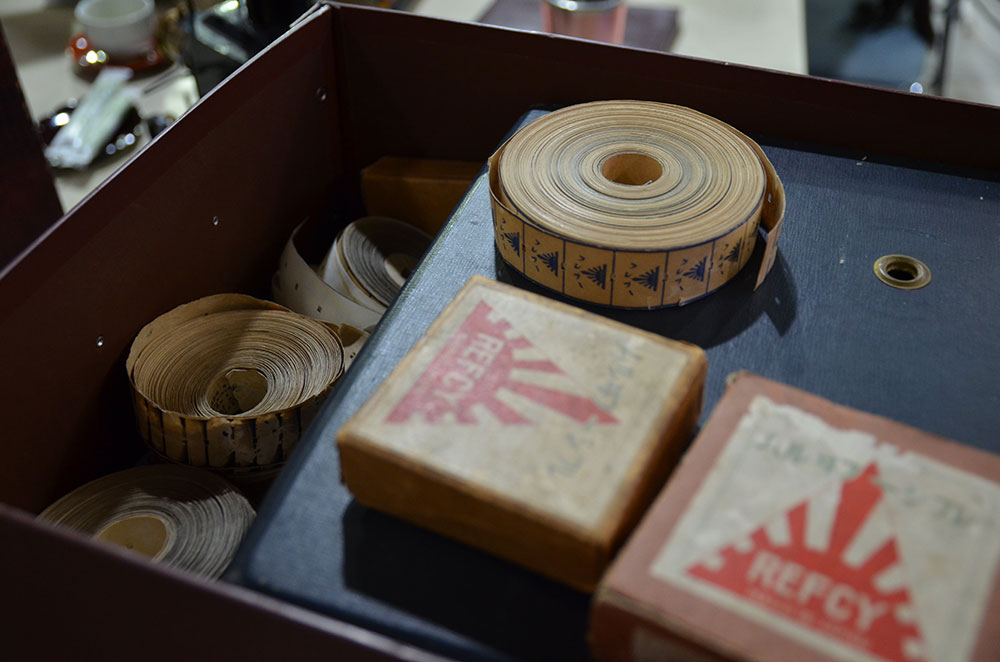What is “new” media today? Is it when AI generates an endlessly randomized stream of different images, or when we watch a film in a theater by physically experiencing the content in 4DX? “New” is often just a reframing of what already exists. Consider the close relationship between illustration, comics, story-boarding, and animation: each is a distinctly different approach to image-making, but all of them present sequential art in related ways. Is the printed flip-book a comic or an animation? Can it be both? Although technologies for showing animation were developed in the early nineteenth century, it wasn’t until 1878 that Eadweard Muybridge managed to photograph the movement of a running horse in a frame-by-frame succession, printed on cabinet cards. He then painted the images onto glass discs and projected them in their chronological sequence as animated films.
About 50 years after Muybridge’s The Horse in Motion, paper films began to be produced in Japan as an alternative to the celluloid market. These films from the 1930s, known as kami firumu, feature live-action footage as well as early anime, and were made of paper strips glued together by hand, sometimes accompanied by soundtracks on 78 RPM records. But their variable qualities, including differences in paper quality and inconsistent perforations that were often floating within the image frame, were likely part of the paper film’s demise as World War II violently disrupted both entertainment and resources in Japan. Few paper films have since survived and those that have are too delicate to be projected in their intended format. Because of this, they cannot actually be seen as films at all: a roll of film is only an object of printed still images until motion activates an audience’s perception of it as a moving image. Without motion, there is no illusion, and without the illusion, moving images simply do not exist. It’s The Horse in Motion on cabinet cards all over again.
Tonight, the film and media professor Eric Faden will present a selection of over two dozen silent and sync-sound films preserved by the Japanese Paper Film Project, which he leads at Bucknell University. They’ve recorded nearly 200 endangered films, including the political animation Japanese People are Here about a hostage situation in Manchuria; live-action and animated tellings of the 47 Rōnin story; and many short and cute animes like the silent Train Trip and the humorous Animal Olympics. Several works feature narration by a benshi, a Japanese performer who provides live voice-over.
To preserve the works, the team at Bucknell built a scanner that they’ve named Kyōrinrin, after the Japanese spirit who protects scrolls and papers that have been lost or forgotten. This very idea of safekeeping material documents is perfectly invoked today by reincarnating paper into the spirited realm of RGB pixels: scanning is the cryogenics of 2D objects. The team’s Kyōrinrin uses a Blackmagic 6K camera to perform a telecine capture of the paper films in motion, which are moved through the “scanning” rig via a low-torque motor rather than using the unreliable perforations; the motor reduces force if it encounters any resistance from the paper passing through the machine. Software then stabilizes the frames after aligning the consecutive images from the raw footage. At the end of all this is a digitized version of the original paper object, which we can now call a movie.
There is something uncanny about watching the visibly worn sprocket holes, abstract dirt marks and stains, and folded creases that appear and disappear on the paper as the animations play. Rather than distract from the content, they magnify the sense that the paper itself is coming to life as it rapidly changes on-screen right before viewers’ eyes; meanwhile, the printed characters in the images seem not to take any notice of what mortality surrounds them. Whether or not the moving content appears realistically “alive,” it’s impossible to ignore that the material plane very much is—and decaying—as captured in the Kyōrinrin recordings. These Japanese paper films are stark reminders of cinema’s material history, and how that history is being brought into the present for the sake of the future.
Japanese Paper Films takes place tonight, August 6, at Light Industry, with live koto music by Yoko Reikano Kimura accompanying the silent pieces.



